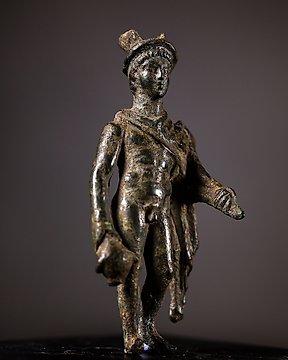
Oud-Romeins Brons God Mercurius figuur - 9 cm
Nr. 80567447

Nr. 80567447

Votive Head Figure.
Iberian
5th - 1st century BC
Bronze
3.2 cm height and 7.5 cm height with stand.
PROVENANCE: Private collection, Estepona, Malaga.
CONDITION: Good condition, intact.
DESCRIPTION:
Head made in bronze in the round, representing a human head adorned with a conical headdress, placed so that the brim forms a circle around the face. The nose and mouth are carefully modelled, with full lips, although the eyes are typical of the iconography of the Iberian ex-voto: large and fixed, symbolically reflecting the link with the supernatural world. The ears have also been worked in relief.
From the shape of the headdress, this piece can be related to an ex-voto depicting a praying lady, preserved in the National Archaeological Museum and from the collection of Carlos Walter Heiss (fig. 1).
The name Iberian refers to the human groups that inhabited the Mediterranean and southern areas of the Iberian Peninsula between the 4th century BC and the Romanisation of the area, until the 1st century BC. The Iberian culture therefore extended over a wide area stretching from Andalusia to Languedoc in southern France. It was a creative, advanced civilisation, sustained by a society organised around fortified hilltop cities, strongly hierarchical and linked by trade with the Greeks and Phoenicians.
The Iberians developed their own art, with a marked personality and, at the same time, permeable to Eastern influences, especially those of classical and Hellenistic Greece. Indissolubly linked to religion, Iberian art is related to funerary beliefs and the development of sanctuaries, which had a dual function as a sacred place and as a border marker. The interpretation of the works of art found in Iberian necropolises and sanctuaries allows us to learn about the beliefs of this people, their legends and even the personal religiosity of individuals.
Particularly noteworthy are the votive offerings, one of the most characteristic manifestations of Iberian culture, generally made in lost-wax bronze, although they have also been preserved in stone and terracotta. These are small statuettes, around 10 cm in height (the largest are no more than 25 cm), commissioned by high-ranking figures to be offered in the sanctuaries in exchange for protection, well-being, health or prosperity. In fact, most of them have been found in the cave sanctuaries of Despeñaperros, Sierra Morena and Castellar, in Jaén, as well as in La Luz, Murcia. Although they are a very heterogeneous group, they are generally stylised images of men or women in a reverential attitude, with exaggerated features or sexual organs (in the case of those related to fertility), although there are also known votive offerings representing horsemen, horses and other animals and also parts of the body, the latter related to the healing of illnesses or specific limbs.
BIBLIOGRAPHY:
- ARANEGUI GASCÓ, C. Los íberos ayer y hoy. Arqueologías y culturas. Marcial Pons Historia. 2017.
- BERMEJO TRIADO, J. Breve historia de los íberos. Nowtilus. 2010.
- PRADOS TORREIRA, L. Exvotos ibéricos de bronce del Museo Arqueológico Nacional. Ministerio de Cultura. 1992.
- QUESADA SANZ, F. “Los íberos y la cultura ibérica”, en CELESTINO PÉREZ, S., coord., La protohistoria en la Península Ibérica. Akal. 2017.
- RUEDA GALÁN, C.; HERRANZ SÁNCHEZ, A.B.; BELLÓN RUIZ, J.P., coord. Exvotos íberos. Paisajes sagrados, peregrinaciones y ritos. Universidad de Jaén. 2021.
- RUIZ, A.; MOLINOS, M. Los íberos. Análisis arqueológico de un proceso histórico. Grijalbo. 1993.
- TARRADELL, M. Arte ibérico. Polígrafa. 1968.
- VV.AA. Revista de Estudios Ibéricos. Universidad Autónoma de Madrid. 1994-1998.
PARALLELS:
Fig. 1 Exvoto de dama orante. España, s. IV-I a.C. Bronce. Museo Arqueológico Nacional, Madrid, inv. 1942/100/135.
Notes:
- The piece includes authenticity certificate.
- The piece includes Spanish Export License (Passport for European Union) - If the piece is destined outside the European Union a substitution of the export permit should be requested, can take between 1-2 weeks maximum.
- The seller guarantees that he acquired this piece according to all national and international laws related to the ownership of cultural property. Provenance statement seen by Catawiki.
Zo koop je op Catawiki
1. Ontdek iets bijzonders
2. Plaats het hoogste bod
3. Veilig betalen